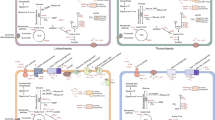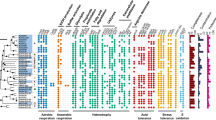Abstract
Glutamine synthetase (GS), an essential enzyme in ammonia assimilation and glutamine biosynthesis, has three distinctive types: GSI, GSII and GSIII. Genes for GSI have been found only in bacteria (eubacteria) and archaea (archaebacteria), while GSII genes only occur in eukaryotes and a few soil-dwelling bacteria. GSIII genes have been found in only a few bacterial species. Recently, it has been suggested that several lateral gene transfers of archaeal GSI genes to bacteria may have occurred. In order to study the evolution of GS, we cloned and sequenced GSI genes from two divergent archaeal species: the extreme thermophile Pyrococcus furiosus and the extreme halophile Haloferax volcanii. Our phylogenetic analysis, which included most available GS sequences, revealed two significant prokaryotic GSI subdivisions: GSI-a and GSI-β. GSIa-genes are found in the thermophilic bacterium, Thermotoga maritima, the low G+C Gram-positive bacteria, and the Euryarchaeota (includes methanogens, halophiles, and some thermophiles). GSI-β-type genes occur in all other bacteria. GSI-α- and GSI-β-type genes also differ with respect to a specific 25-amino-acid insertion and adenylylation control of GS enzyme activity, both absent in the former but present in the latter. Cyanobacterial genes lack adenylylation regulation of GS and may have secondarily lost it. The GSI gene of Sulfolobus solfataricus, a member of the Crenarchaeota (extreme thermophiles), is exceptional and could not be definitely placed in either subdivision. The S. solfataricus GSI gene has a shorter GSI-β-type insertion, but like GSI-a-type genes, lacks conserved sequences about the adenylylation site. We suspect that the similarity of GSI-α genes from Euryarchaeota and several bacterial species does not reflect a common phylogeny but rather lateral transmission between archaea and bacteria.
Similar content being viewed by others
References
Almassy RJ, Janson CA, Hamlin R, Xuong N-H, Eisenberg D (1986) Novel subunit-subunit interactions in the structure of glutamine synthetase. Nature 323:304–309
Altschul SF, Gish W, Miller W, Myers EW, Lipman DJ (1990) Basic local alignment search tool. J Mol Biol 251:403–410
Behrmann I, Hillemann D, Pühler A, Strauch E, Wohlleben W (1990) Overexpression of a Streptomyces viridochromogenes gene (glnII) encoding a glutamine synthetase similar to those of eucaryotes confers resistance against the antibiotic phosphinothricyl-alanylalanine. J Bacteriol 172:5326–5334
Benachenhou-Lahfa N, Forterre P, Labedan B (1993) Evolution of glutamate dehydrogenase genes: evidence for paralogous protein families and unusual branching patterns of the archaebacteria in the universal tree of life. J Mol Evol 36:335–346
Bozouklian H, Elmerich C (1986) Nucleotide sequence of the AzospirMum brasilense Sp7 glutamine synthetase structural gene. Biochimie 68:1181–1187
Cabot EL, Beckenbach AT (1989) Simultaneous editing of multiple nucleic acid and protein sequences with ESEE. Comput Appl Biosci 5:233–234
Carlson TA, Chelm BK (1986) Apparent eucaryotic origin of glutamine synthetase II from the bacterium Bradyrhizobium japonicum. Nature 322:568–570
Cavalier-Smith T (1992) Origins of secondary metabolism. In: Secondary metabolites: their function and evolution. Ciba Foundation symposium 171, Wiley, Chichester, pp 64–87
Cavalier-Smith T (1983) A 6-kingdom classification and a unified phylogeny. In: Schenk HAE, Schemmler WS (ed) Endocytobiology II: intracellular space as oligogenetic, vol 2. De Gruyter, Berlin, pp 1027–1034
Charlebois RL, Hofman JD, Schalkwyk LC, Lam WL, Doolittle WF (1989) Genome mapping in halobacteria. Can J Microbiol 35: 21–29
Charlebois RL, Lam WL, Cline SW, Doolittle WF (1987) Characterization of pHV2 from Halobacterium volcanii and its use in demonstrating transformation of an archaea. Proc Natl Acad Sci USA 84:8530–8534
Chiurazzi M, Meza R, Lara M, Lahm A, Defez R, Iaccarino M, Espin G (1992) The Rhizobium leguminosarum bivar phaseoli glnT gene, encoding glutamine synthetase III. Gene 119:1–8
Cohen A, Lam WL, Charlebois RL, Doolittle WF, Schalkwyk LC (1992) Localizing genes on the map of the genome of Haloferax volcanii. Proc Natl Acad Sci USA 89:1602–1606
Conover RK, Doolittle WF (1990) Characterization of a gene involved in histidine biosynthesis in Halobacterium (Haloferax) volcanii: isolation and rapid mapping by transformation of an auxotroph with cosmid DNA. J Bacteriol 172:3244–3249
Corpet F (1988) Multiple sequence alignment with hierarchical clustering. Nucleic Acids Res 16:10881–10890
Darrow RA, Knotts RR (1977) Two forms of glutamine synthetase in free-living root-nodule bacteria. Biochem Biophys Res Commun 78:554–559
Edmands J, Noridge NA, Benson DR (1987) The actinorhizal root-nodule symbiont Frankia sp. strain CpII has two glutamine synthetases. Proc Natl Acad Sci USA 84:6126–6130
Felsenstein J (1993) PHYLIP (Phylogeny Inference Package) version 3.5c. Distributed by the author. Department of Genetics, University of Washington, Seattle
Fiala G, Stetter KO (1986) Pyroccocus furiosus, sp. nov., represents a novel genus of marine heterothrophic archaea growing optimally at 100°C. Arch Microbiol 145:56–61
Fisher R, Tuli R, Haselkorn R (1981) A cloned cyanobacterial gene for glutamine synthetase functions in Escherichia coli, but the enzyme is not adenylylated. Proc Natl Acad Sci USA 87:3393–3397
Gogarten JP, Kibak H, Dittrich P, Taiz L, Bowman EJ, Bowman BJ, Manolson NF, Poole RJ, Date T, Oshima T, Konishi J, Denda K, Yoshida M (1989) Evolution of the vacuolar H+-ATPase: implications for the origin of eukaryotes. Proc Natl Acad Sci USA 86: 6661–6665
Goodman HJK, Woods DR (1993) Cloning and nucleotide sequence of the Butyrivibrio frbrisolvens gene encoding a type III glutamine synthetase. J Gen Microbiol 139:1487–1493
Gupta RS, Singh B (1992) Cloning of the HSP70 gene from Halobacterium marismortui: Relatedness of archaebacterial HSP70 to its eubacterial homologs and a model for the evolution of the HSP70 gene. J Bacteriol 174:4594–4605
Hain J, Reiter W-D, Hüdepohl U, Zillig W (1992) Elements of an archaeal promoter defined by mutational analysis. Nucleic Acids Res 20:5423–5428
Hill RT, Parker JR, Goodman HJK, Jones DT, Woods DR (1988) Molecular analysis of a novel glutamine synthetase of the anaerobe, Bacteroides fragilis. J Gen Microbiol 135:3271–3279
Iwabe N, Kuma K-I, Hasegawa M, Osawa S, Miyata T (1989) Evolutionary relationship of archaea, bacteria, and eukaryotes inferred from phylogenetic trees of duplicated genes. Proc Natl Acad Sci USA 86:9355–9359
Janssen PJ, Jones WA, Jones DT, Woods DR (1988) Molecular analysis and regulation of the glnA gene of the Gram-positive anaerobe Clostridium acetobutylicum. J Bacteriol 170:400–408
Kumada Y, Benson DR, Hillemann D, Hosted TJ, Rochefort DA, Thompson CJ, Wohlleben W, Tateno Y (1993) Evolution of the glutamine synthetase gene, one of the oldest existing and functioning genes. Proc Natl Acad Sci USA 90:3009–3013
Kumada Y, Takano E, Nagaoka K, Thompson CJ (1990) Streptomyces hygroscopicus has two glutamine synthetase genes. J Bacteriol 172: 5343–5351
Pesole G, Bozzetti MP, Lanave C, Preparata G, Saccone C (1991) Glutamine synthetase gene evolution: A good molecular clock. Proc Natl Acad Sci USA 88:522–526
Possot O, Sibold L, Aubert JP (1989) Nucleotide sequence and expression of the glutamine synthetase gene, glnA of the archaea Methanococcus voltae. Res Microbiol 140:355–371
Reitzer LJ, Magasanik B (1987) Ammonia assimilation and the biosynthesis of glutamine, glutamate, aspartate, asparagine, L-alanine and D-alanine. In: Neidhardt FC, Ingraham JL, Low KB, Magasanik B, Schaechter M, Umbarger HE (ed) Escherichia coli and Salmonella typhimurium: cellular and molecular biology. American Society of Microbiology, Washington, DC, pp 302–320
Rochefort DA, Benson DR (1990) Molecular cloning, sequencing and expression of the glutamine synthetase II (glnII) gene from the actinomycete root nodule symbiont Frankia sp. strain CpIl. J Bacteriol 172:5335–5342
Rossi M, Defez R, Chiurazzi M, Lamberti A, Fuggi A, Iaccarino M (1989) Regulation of glutamine synthetases isoenzymes in Rhizobium leguminosarum biovar viciae. J Gen Microbiol 135: 629–637
Sambrook J, Fritsch EF, Maniatis T (1989) Molecular cloning: a laboratory manual, 2nd ed. Cold Spring Harbour Laboratory, Cold Spring Harbor, NY
Sanangelantoni AM, Barbarini D, Di Pasquale G, Cammarano P, Tiboni O (1990) Cloning and sequencing of an archaeal glutamine synthetase gene: phylogenetic implications. Mol Gen Genet 221:187–194
Schof WJ (1993) Microfossils of the early archean apex chert: new evidence of the antiquity of life. Science 260:640–646.
Shapiro BM, Stadtman ER (1968) 5′-Adenylyl-O-tyrosine. The novel phosphodiester of adenylylated glutamine synthetase from Escherichia coli. J Biol Chem 243:3769–3771.
Shatters RG, Kahn ML (1989) Glutamine synthetase II in Rhizobium: Re-examination of the proposed horizontal transfer of DNA from eukaryotes to prokaryotes. J Mot Evol 29:422–428
Shen W, Waye MMY (1989) A novel method for generating a nested set of unidirectional deletion mutants using mixed oligodeoxynucleotides. Gene 70:205–211
Smith MW, Feng D-F, Doolittle RF (1992) Evolution by acquisition: the case for horizontal gene transfers. Trends Biochem Sci 17:489–493
Sogin ML (1989) Evolution of eukaryotic microorganisms and small subunit ribosomal RNAs. Am Zool 29:487–499
Sogin ML (1991) Early evolution and the origin of eukaryotes. Curr Opin Gene Dev 1:457–463
Strauch MA, Aronson AI, Brown SW, Schreier HJ, Sonenshein AL (1988) Sequence of the Bacillus subtilis glutamine synthetase gene region. Gene 71:257–265
Streicher SL, Tyler B (1981) Regulation of glutamine synthetase activity by adenylylation in the Gram-positive bacterium Streptomyces cattleya. Proc Natl Acad Sci USA 78:229–233
Swofford DL (1993) PAUP: phylogenetic analysis using parsimony, version 3.1 computer program. Distributed by the Illinois Natural History Survey, Champaign, IL
Tiboni O, Cammarano P, Sanangelantoni AM (1993) Cloning and sequencing of the gene encoding glutamine synthetase I from the archaeum Pyrococcus woesei. anomalous phylogenies inferred from analysis of archaeal and bacterial glutamine synthetase I sequences. J Bacteriol 175:2961–2969
Tiboni O, Cantoni R, Creti R, Cammarano P, Sanangelantoni AM (1991) Phylogenetic depth of Thermotoga maritima inferred from analysis of the fus gene: amino acid sequence of elongation factor G and organization of the Thermotoga str operon. J Mol Evol 33:142–151
Usdin KP, Zappe H, Jones DT, Woods DR (1986) Cloning, expression and purification of glutamine synthetase from Clostridium acetobutylicum. Appl Environ Microbiol 52:413–419
Woese CR (1987) Bacterial evolution. Microbiol Rev 51:221–271
Woese CR (1991) The use of ribosomal RNA in reconstructing evolutionary relationships among Bacteria. In: Selander RK, Clark AG, Whittam TS (eds) Evolution at the molecular level. Sinauer Associates, Sunderland, MA, pp 1–24
Wray LV, Fisher SH (1988) Cloning and nucleotide sequence of the Streptomyces coelicolor gene encoding glutamine synthetase. Gene 71:247–256
Zillig W (1991) Comparative biochemistry of Archaea and Bacteria. Curr Opin Gene Dev 1:457–463
Author information
Authors and Affiliations
Additional information
Correspondence to: J.R. Brown 1073
Rights and permissions
About this article
Cite this article
Brown, J., Masuchi, Y., Robb, F. et al. Evolutionary relationships of bacterial and archaeal glutamine synthetase genes. J Mol Evol 38, 566–576 (1994). https://doi.org/10.1007/BF00175876
Received:
Accepted:
Issue Date:
DOI: https://doi.org/10.1007/BF00175876




